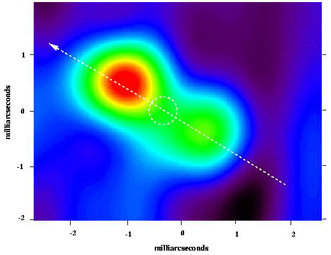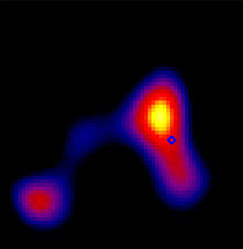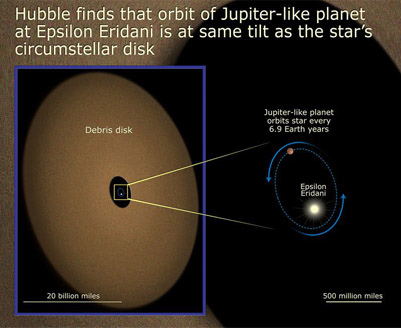Luyten 726-8 AB (UV Ceti)
"Luyten 726-8 AB is the sixth closest system to Sol. The system is located only about 8.7 light-years away in the southwestern part (01:39:01-17:57.0:C~, ICRS 2000.0) of Constellation Cetus, the Whale -- northeast of Deneb Kaitos or Diphda (Beta Ceti). However, this binary system of red dwarf stars is too faint to be seen with the naked eye. The stars were discovered in 1949 by Willem Jacob Luyten (1899-1994), who found the proper motions of over 520,000 stars despite the loss of sight in one eye since 1925 by building an automated photographic plate scanner and measuring machine. Although both stars have been found to be flare stars, the fainter member of the system is considered to be an extreme example; it has been given the variable star designation UV Ceti but is also referred to as "Luyten's Flare Star."(Solstation)
 Credit:Arnold O. Benz, Institute of Astronomy, ETH Zurich Credit:Arnold O. Benz, Institute of Astronomy, ETH Zurich
|
UV Ceti (L 726-8 B) A flaring UV Ceti was resolved as at least two evolving spatial components that were separated by four to five stellar radii, in this VLBA/VLA radio image at 3.6 cm wavelength. The components changed in appearance over about six hours of observation but stayed aligned along the axis of the binary orbit, as shown by the arrow. |
UV Ceti (L 726-8 B) as the dimmer of the pair is main sequence red dwarf star (M6.0 Ve) may have only 10 percent of Sol's mass (Geyer et al, 1988; and RECONS estimate), 14 percent of its diameter (Johnson and Wright, 1983, page 649), and less than 4/100,000th of its luminosity. However, UV Ceti is an extreme example of a flare star that can boost its brightness by five times in less than a minute, then fall somewhat more slowly back down to normal luminosity within two or three minutes before flaring suddenly again after several hours. In 1952, UV Ceti was observed flaring to 75 times its normal brightness in only 20 seconds.(Solstation)
Sources:
- http://www.solstation.com/stars/luy726-8.htm
Nearby Stars
Star Concepts
| HyperPhysics***** Astrophysics | R Nave |

